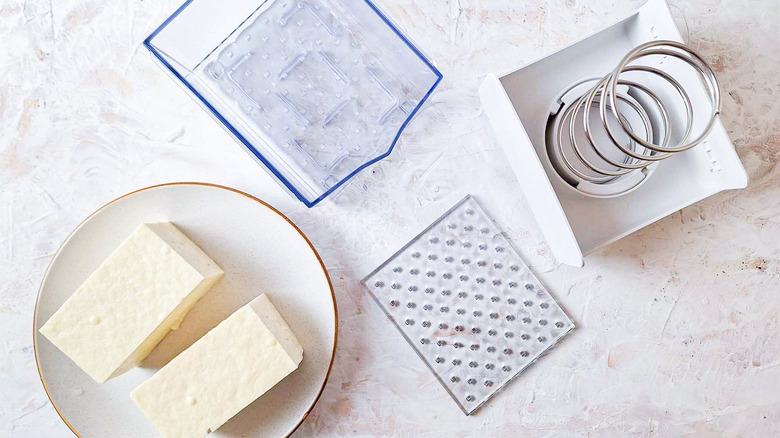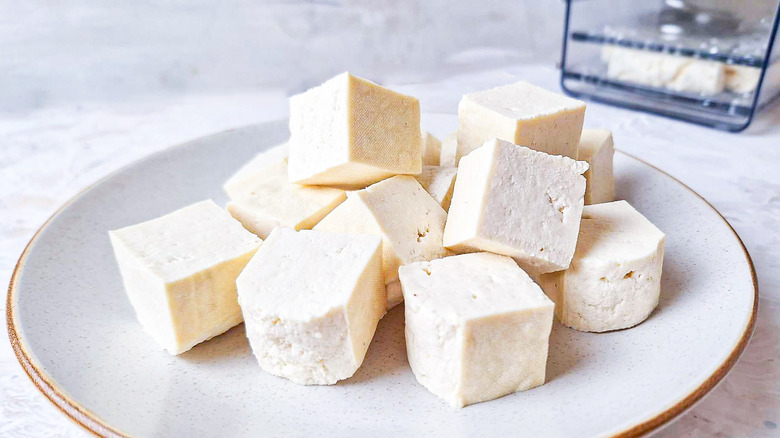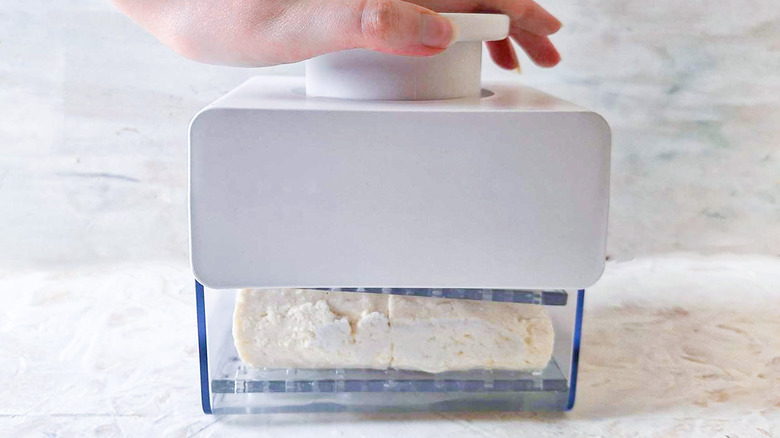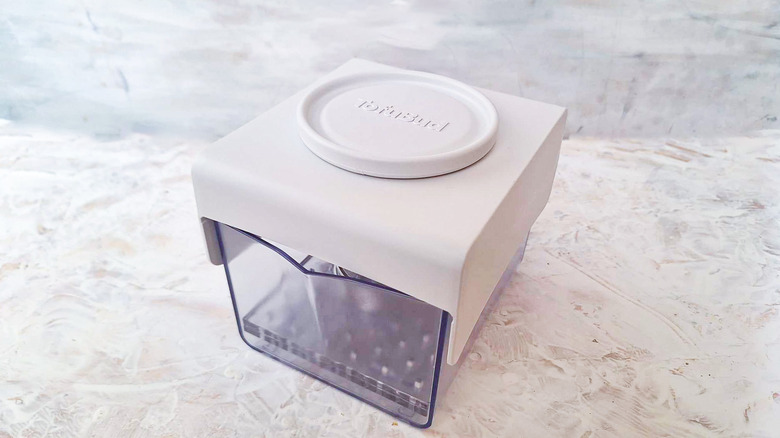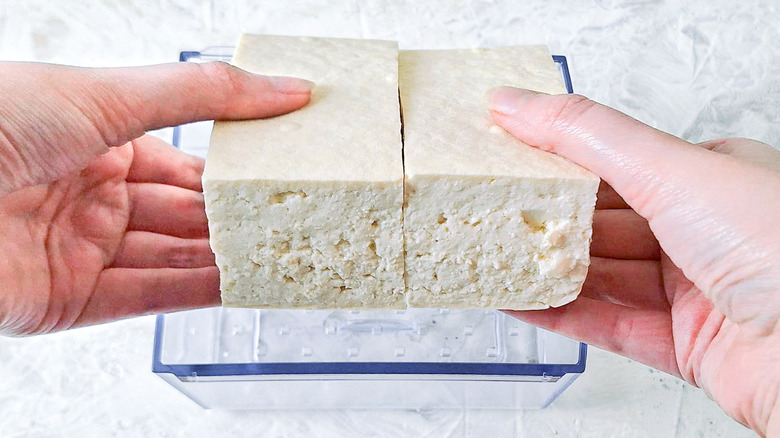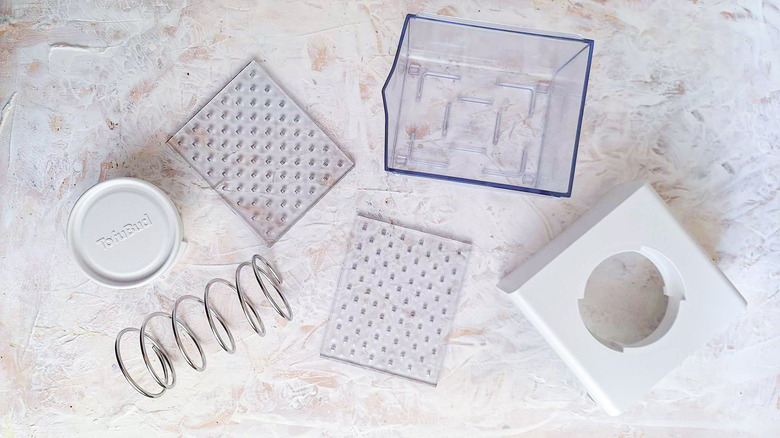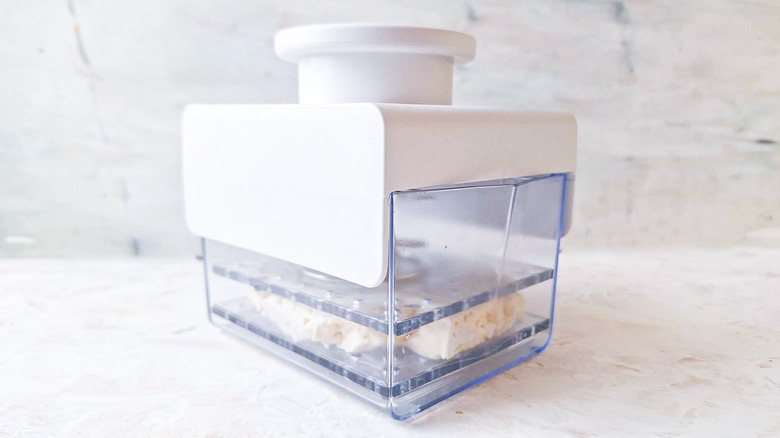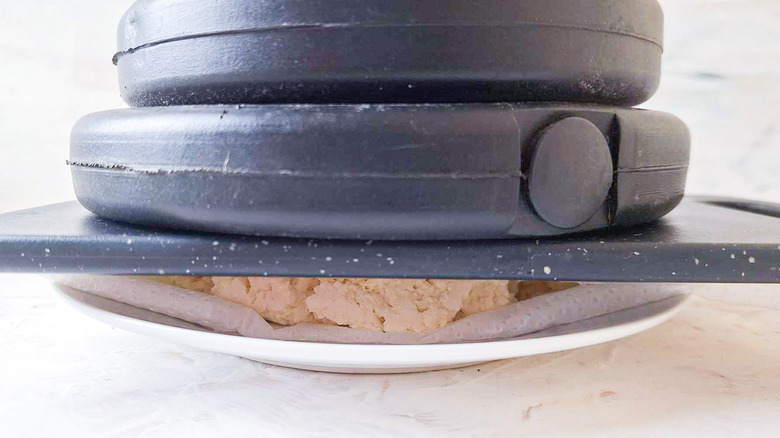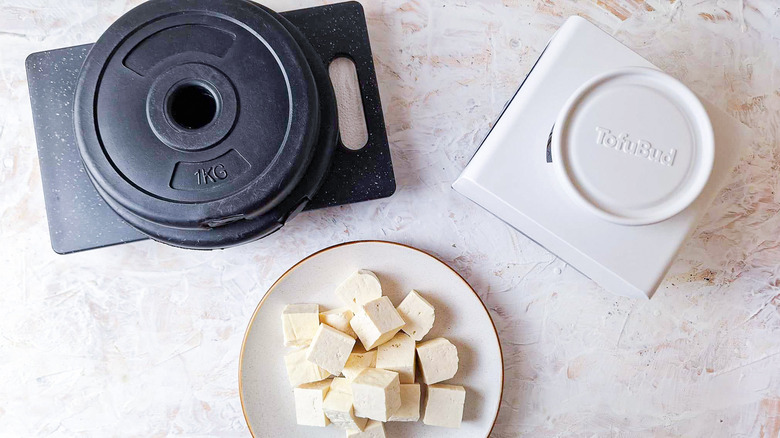Are Tofu Presses Really Worth Buying?
Love it or hate it, tofu is here to stay. Also known as bean curd, tofu is far from a fad; it has legendary origins dating back millennia and continues to be an indispensable and versatile staple across much of Asia. In the West, tofu is still chiefly associated with plant-based eating, where it arose as a protein-packed hero — but the ingredient is becoming increasingly mainstream across all diets.
I've been a vegetarian from birth, but when I started earnestly cooking for myself in 2013, I didn't know what to do with tofu. I'm not afraid to admit I never bothered with a tofu press — I'd throw the cubed bean curd straight into my meals without a second glance. Technically, a tofu press isn't required (plenty of Asian recipes prize tofu for its unpressed spongy and soft texture), but for many who previously deemed tofu "tasteless" or "boring," pressing tofu has revolutionized their diets. And me? I probably cook tofu at least once a week, so I've racked up years of experience with various tofu presses, from makeshift versions to online bestsellers.
But I want to get to the pressing questions (pun intended). Do I regret all those years I didn't use a tofu press? What does pressing tofu do, anyway? Is a tofu press worth it? Regardless if you're learning about tofu for the first time or considering a tofu press for a while, keep reading.
What is the point of a tofu press?
Before your tofu even hits the pan (or, for that matter, the marination bowl), the first step of any given recipe is usually "press your tofu." But have you ever wondered why this extra step is necessary; do you need to press tofu, or is it merely a waste of time?
The answer isn't straightforward. Instead, it lies in your end goal. While most Asian cooks don't traditionally press tofu, the protein-packed ingredient has become a vital meat alternative for vegetarians and vegans, resulting in numerous home chefs aiming for a meaty texture. The tofu press seriously shines here.
Pressing tofu changes its texture dramatically. Firm (or even extra-firm) tofu — the most widespread recipe choice — may still contain surprising amounts of unwanted water, depending on the brand. Placing pressure on the tofu (through a tofu press, either bought or homemade) extracts the excess water and transforms its texture from watery and spongy to dense and chewy. Going through this metamorphosis makes it possible for tofu to absorb the beautiful flavors of marinades, broths, and spiced sauces. It also helps the tofu to crisp up, ideal for dishes like baked General Tso's tofu that rely on that golden-brown crunchy exterior.
Models of tofu presses vary greatly
Before you evaluate whether a tofu press is a worthy investment, it's worth researching the different types of tofu press on the market. There are multiple things to consider: the material, the design, and the pressing mechanism.
I gravitated toward a plastic tofu press, as it has the benefit of easy cleaning (most are dishwasher safe). Conversely, while bamboo is aesthetic and often antibacterial, it can only be hand-washed and requires careful upkeep. Due to the material, the design of the tofu press also tends to be much more simplistic, which can be a drawback. The last popular material, stainless steel, combines durability and functionality, although it's arguably less visually attractive.
Other considerations include whether the tofu press has a built-in drainage system (you'll find this extremely useful, as otherwise, the tofu remains waterlogged), its size (you'll want to make sure it aligns with your favorite brand of tofu), and perhaps most crucially, the pressing function. Some use a straightforward screw mechanism, while others have built-in springs that adjust to the size of your tofu, and more up-market presses combine the screw-spring system. Which you choose also affects how evenly the tofu presses; I learned that latches on either side exert even pressure, while a center spring or screw can make for lopsided results.
How expensive is a tofu press?
If you're worried about affordability, you'll be shocked to discover a tofu press for virtually every budget. People often use its reputation as the one-trick pony of kitchen appliances as a reason not to invest. But, at the economic range of $10 to $15, there are countless options. For example, Helen's Asian Kitchen press offers a basic striped back design, although the stainless steel screw mechanism may be fiddly for people with limited mobility. The dishwater-safe, spring-operated Pavsrmy tofu press presents a more detailed design at an affordable price but may not stand up to constant use.
Mid-range is where all the best-selling tofu presses are. For $15 to $30, you can take your pick from the NOYA tofu press, with depth markings and adjustable pressure; a compact yet slow-pressing offering from brand leader Tofuture; the eco-friendly YARKOR bamboo tofu press with a built-in drip tray; and the remarkably fast-acting TofuBud press, which I own.
The final price range opens you up to different materials — namely, stainless steel. The Nijsaku tofu press is slightly shy of $30, and reviewers rave about the streamlined design with one central screw and bearing beam, claiming it's easy to clean and powerful. U.S.-made Raw Rutes ninja tofu press is undoubtedly the most expensive option, clocking in at over $100. The brand claims it's "the last tofu press you'll ever buy," boasting a simple weighted press with quality materials.
How to use a tofu press correctly
Most tofu presses I've used throughout the years have been easy to operate. Plus, it's standard for most companies to include a small instruction booklet explaining how to arrange the various parts and get them working. I highly recommend not skipping this step (I've been guilty of not reading the booklets more times than I can count, but this will only take a few minutes, trust me), as it avoids accidental breakages while trying to put things together. Some brands even include a few tasty tofu recipes alongside the instructions, so it's 100% worth reading. Of course, how the tofu press is put together and used depends very much on the brand — but there are some universal mistakes you should avoid with your tofu press.
Take your tofu and place it between the two plates. Most tofu presses have adjustable pressure — you'll want to tighten the press now, either through the screw or spring mechanism. I recommend starting with a lower pressure, as the other levels are usually reserved for exceptionally thick blocks of tofu. Leave for the recommended time — usually 10 minutes to an hour — then carefully release the pressure and remove your tofu. Following these instructions, you should get the best out of a tofu press.
Having a tofu press saves on the cleanup (most of the time)
Is there anything worse than spending hours cooking a meal, only to eat the food in minutes, and then again have to spend hours cleaning up? I'm sure you'd agree that the less cleaning to do, the better — and this is where the tofu press deserves serious kudus.
Unlike a DIY tofu press, which often involves a delicate balancing act of plates, paper towels, tofu, and weights (or a stack of the heaviest cans you can find), a tofu press makes the whole operation trouble-free. Despite both options having roughly the same number of elements to clean, anyone who has pressed enough tofu using the stacking method can confirm it's not abnormal to go through countless paper towels only for water to still spill onto the counter and, on unlucky occasions, for the whole pile to collapse. Conversely, the box boundaries of most professional tofu presses avoid all these issues; some even come complete with a handy drainage bottom and spout.
Notably, that's not always the case. More simplistically designed tofu presses with open sides can suffer the same spillages as a homemade press. Additionally, wood or bamboo presses aren't dishwasher friendly, meaning more time at the sink. The average tofu press, though? They unquestionably save time on clean-up.
Keep in mind: Your tofu may not fit the press
There are a staggering 15 types of tofu. But even the most common variety for pressing (firm tofu) has width, height, and density variations depending on the manufacturer. Isolated, this lack of conformity isn't an issue — you've likely never given it a second thought. However, once you start using a tofu press, you have to pay attention.
Why? Tofu presses don't follow set guidelines, either. Because they come in all different shapes and sizes, coordinating your tofu to the tofu press can be compared to matching Cinderella to her glass slipper. Ideally, you'll want to find a press you can use without troubling yourself by having to either pre-cut the tofu to fit (what a hassle) or having tons of excess space in the press — this is disastrous, as it can cause the tofu to burst at the sides, resulting in an uneven block with curd-like edges.
The latter point highlights another inherent flaw in the tofu press: it's impractical for small-batch cooking. For the tofu press to work its magic, you'll need at least a full slab of tofu (I needed two). If you've already used half a block for a recipe that doesn't require pressing, such as stir-fried bok choy with tofu cream, you'll struggle to press the remaining tofu. In short? Tofu presses aren't great for spontaneous cooks.
If space is an issue, owning a tofu press may not be worth it
I have a tiny kitchen. I also consider myself a definite foodie, the proof being in my overflowing cupboards stacked to the brim with obscure ingredients and an extensive collection of cooking appliances that have outgrown my room. If you similarly struggle with minimal counter space and even less storage, you'll understand the challenge of adding a new kitchen gadget to the collection: It has to be 100% worth it, or the purchase won't happen.
On the scale of things, a tofu press is far from unmanageable, especially not when compared to a stand mixer or pressure cooker. Often square or rectangular, they also benefit from easy stacking and effortlessly slip into cabinet corners. But if you're in a shared space — or, like me, still far from the dream of a magazine-worthy kitchen and pressed for room — it might be more sensible to rustle up a homemade version despite its shortcomings. Comparatively, a DIY tofu press uses essentials already in your kitchen (such as plates and heavy cans), making it more cost and space-efficient.
Tofu presses are really worth buying
Now I've taken you through all the details, it's time for my verdict. And, spoiler alert — a tofu press is worth buying, especially considering its relative affordability. While there are setbacks (hello, storage space), it's a compromise I'm willing to make when considering all the other benefits. If you cook tofu regularly, you won't regret having this tool in your arsenal; in fact, I'd go so far as to say it's a game-changer.
Ultimately, the deciding factor? It saves time. Previously, I would set up my makeshift press hours ahead of time — I knew it would take at least four hours. Now, with a tofu press in hand, it takes less than 15 minutes to literally halve the size of the tofu, achieving an enviable dense and chewy texture even tofu skeptics wouldn't dare balk at. You can use this time for prepping other ingredients, or to get a head-start on cooking. Moreover, I can finally join in on trends like freezing and defrosting tofu to make vegan chicken wings. For me, these conveniences are worth the purchase price 10 times over.
The figurative cherry on top was, that despite the rhetoric, I've discovered a tofu press is far from a single-use tool. I've already used my empty press as a marination bowl to infuse flavor into the tofu and even lined it with cheesecloth to try my hands at making homemade paneer. Next up? Well, I've decided the sky is the limit.
